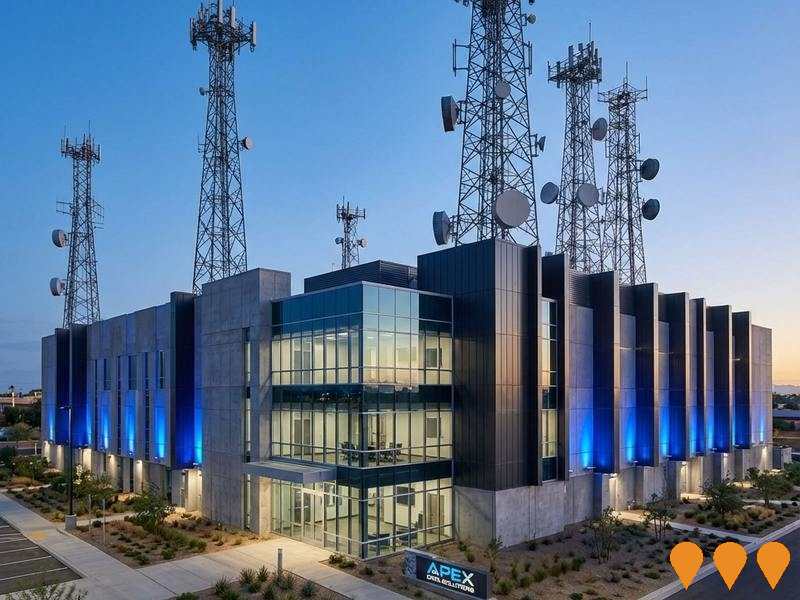Chart Color Schemes
est. as @ -- *
ABS ERP | -- people | --
2021 Census | -- people
Sales Activity
Curious about local property values? Filter the chart to assess the volume and appreciation (including resales) trends and regional comparisons, or scroll to the map below view this information at an individual property level.
Find a Recent Sale
Sales Detail
Population
Woodend lies within the top quartile of areas nationally for population growth performance according to AreaSearch analysis of recent, and medium to long-term trends
Woodend's population was approximately 8,053 as of Aug 2025. This figure shows an increase of 104 people since the 2021 Census, which reported a population of 7,949 people. The change is inferred from the estimated resident population of 8,035 in June 2024 and an additional 63 validated new addresses since the Census date. This results in a density ratio of 38 persons per square kilometer. Over the past decade, Woodend has shown resilient growth patterns with a compound annual growth rate of 1.6%, outperforming its SA4 region. Interstate migration contributed approximately 53.5% of overall population gains during recent periods.
AreaSearch is using ABS/Geoscience Australia projections for each SA2 area, released in 2024 with a base year of 2022. For areas not covered by this data, AreaSearch utilises the VIC State Government's Regional/LGA projections from 2023, adjusted employing a method of weighted aggregation of population growth from LGA to SA2 levels. Growth rates by age group are applied across all areas for years 2032 to 2041. Future trends indicate a significant population increase in the top quartile of national regional areas, with Woodend expected to expand by 2,874 persons to 2041 based on the latest population numbers, recording a gain of 35.5% over the 17 years.
Frequently Asked Questions - Population
Development
AreaSearch analysis of residential development drivers sees Woodend recording a relatively average level of approval activity when compared to local markets analysed countrywide
Woodend has recorded approximately 33 residential properties granted approval per year. Over the past five financial years, from FY21 to FY25, a total of 166 homes were approved, with an additional 4 approved so far in FY26. On average, each dwelling built over these years attracted around 2.7 new residents annually, indicating strong demand that supports property values.
New homes are being constructed at an average expected cost of $793,000, suggesting developers target the premium market segment with higher-end properties. In terms of commercial development, Woodend has recorded $10.3 million in approvals for this financial year, demonstrating steady investment activity. Compared to other areas in Victoria (Rest of Vic.), Woodend has roughly two-thirds the rate of new dwelling approvals per person and ranks among the 43rd percentile nationally, offering more limited housing choices for buyers and potentially supporting demand for existing homes.
The current building activity shows a predominance of detached houses at 88.0%, with townhouses or apartments making up the remaining 12.0%. This preserves Woodend's low-density nature and attracts space-seeking buyers who prefer detached housing. The estimated population per dwelling approval is 412 people, reflecting its quiet, low-activity development environment. Looking ahead, Woodend is projected to grow by 2,856 residents by the year 2041. If current development rates continue, housing supply may struggle to keep pace with population growth, potentially intensifying buyer competition and supporting price increases.
Frequently Asked Questions - Development
Infrastructure
Woodend has emerging levels of nearby infrastructure activity, ranking in the 23rdth percentile nationally
The performance of an area can significantly be influenced by changes in local infrastructure, major projects, and planning initiatives. AreaSearch has identified six projects that are expected to impact this particular area. Notable among these are the Hanging Rock to Daylesford Shared Trail project, the Hamilton Road Reconstruction from New Gisborne to Riddells Creek, the Macedon Ranges Sports Precinct development, and the Kyneton Recycled Water Irrigation Project. The following list outlines those projects that are likely to be most relevant.
Professional plan users can use the search below to filter and access additional projects.
INFRASTRUCTURE SEARCH
 Denotes AI-based impression for illustrative purposes only, not to be taken as definitive under any circumstances. Please follow links and conduct other investigations from the project's source for actual imagery. Developers and project owners wishing us to use original imagery please Contact Us and we will do so.
Denotes AI-based impression for illustrative purposes only, not to be taken as definitive under any circumstances. Please follow links and conduct other investigations from the project's source for actual imagery. Developers and project owners wishing us to use original imagery please Contact Us and we will do so.
Frequently Asked Questions - Infrastructure
Outer Metropolitan Ring / E6 Transport Corridor
The Outer Metropolitan Ring / E6 Transport Corridor is a long-term planning project to reserve a 100km corridor for a future high-speed freeway and rail link in Melbourne's north and west. It will connect key growth areas from Werribee to Beveridge, linking major freeways and providing capacity for both road and up to four rail tracks for passenger and freight services.

Victorian Renewable Energy Zones
VicGrid, a Victorian Government agency, is coordinating the planning and staged declaration of six proposed onshore Renewable Energy Zones (plus a Gippsland shoreline zone to support offshore wind). The 2025 Victorian Transmission Plan identifies the indicative REZ locations, access limits and the transmission works needed to connect new wind, solar and storage while minimising impacts on communities, Traditional Owners, agriculture and the environment. Each REZ will proceed through a statutory declaration and consultation process before competitive allocation of grid access to projects.
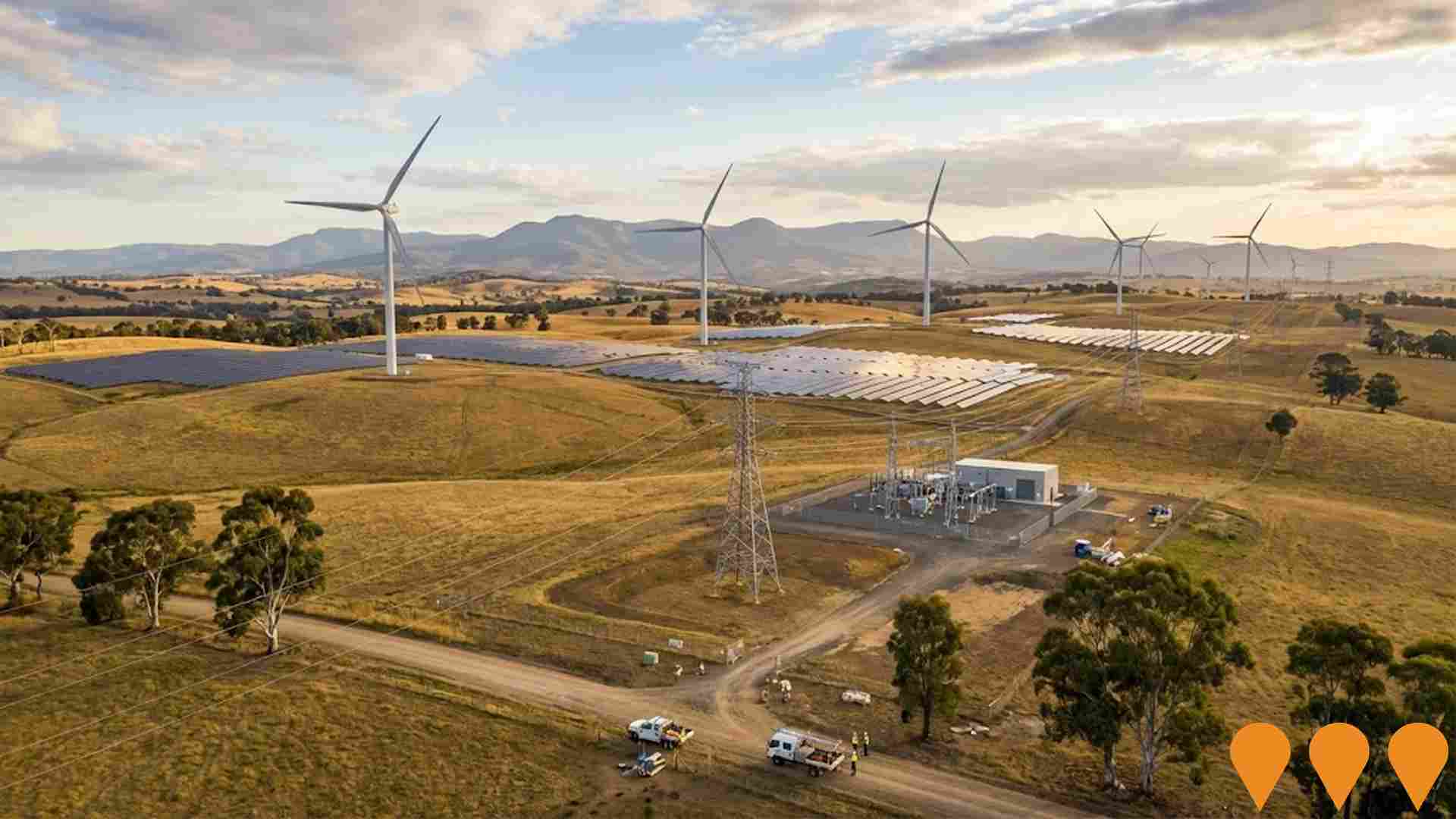
Outer Metropolitan Ring / E6 Transport Corridor
The Outer Metropolitan Ring / E6 Transport Corridor is a proposed 100km high-speed transport link for people and freight in Melbourne's north and west. The project will connect the Princes Freeway near Werribee to the Hume Freeway north of Craigieburn, incorporating a four-lane freeway and a four-track railway line. It aims to support population growth and improve transport connectivity in the outer suburbs, with construction unlikely to commence before 2030.
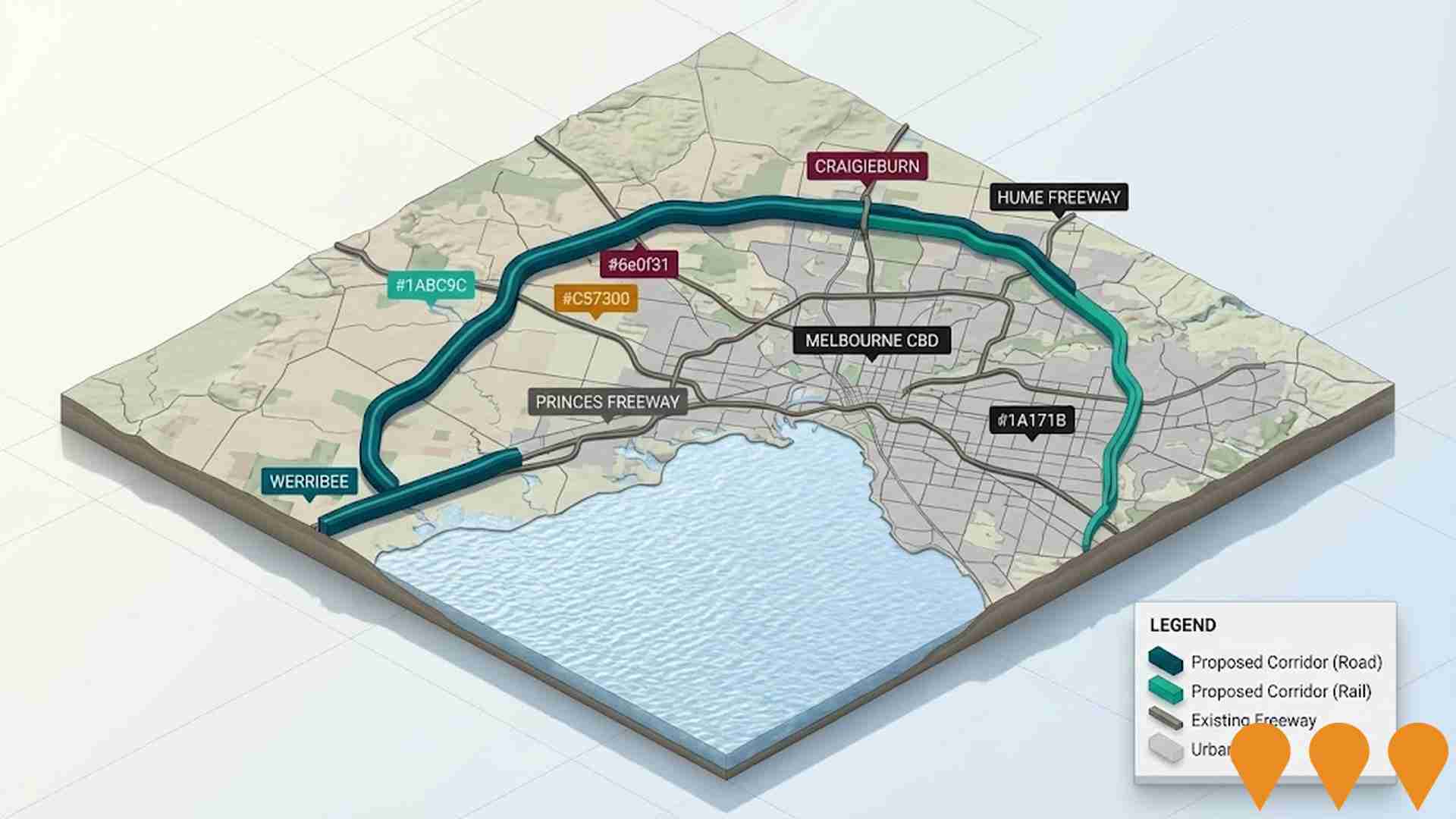
Kyneton Recycled Water Irrigation Project
The project involves the construction of a 14-kilometre pipeline to distribute Class C recycled water from the Kyneton Water Reclamation Plant to local irrigators, enabling the reuse of 200-300 megalitres annually for agricultural irrigation, supporting regional agriculture, and improving environmental outcomes for the Campaspe River by reducing non-compliant discharges.
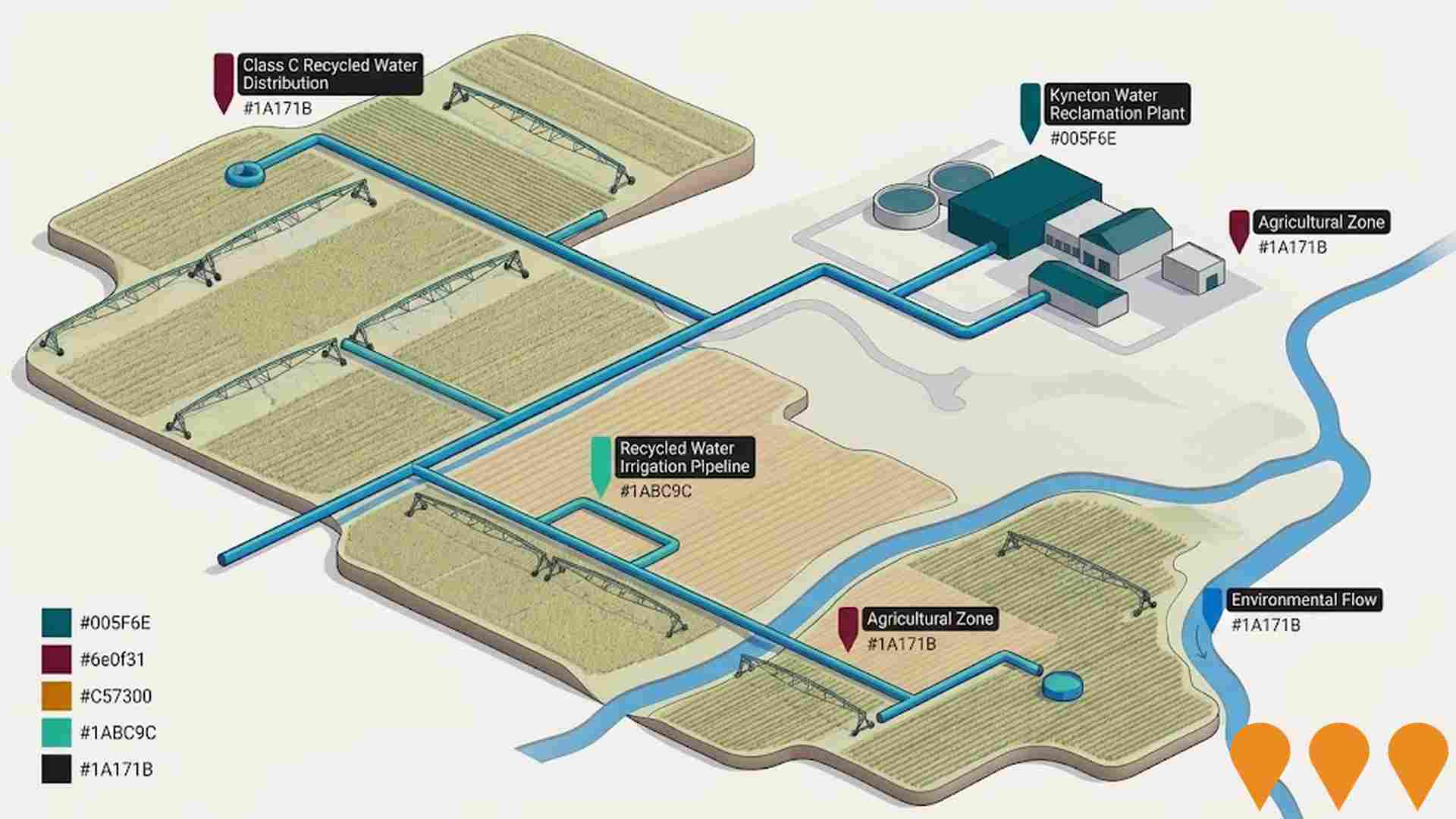
Gisborne Business Park Development
New commercial and industrial development providing employment opportunities for Gisborne region. Mixed-use business park with technology focus, supporting local economic diversification beyond tourism and residential.

Western Renewables Link
Proposed 190km overhead 500kV double circuit high-voltage electricity transmission line from Bulgana in western Victoria to Sydenham in Melbourne's north-west. The project is currently in the EES public exhibition process (30 June to 25 August 2025).
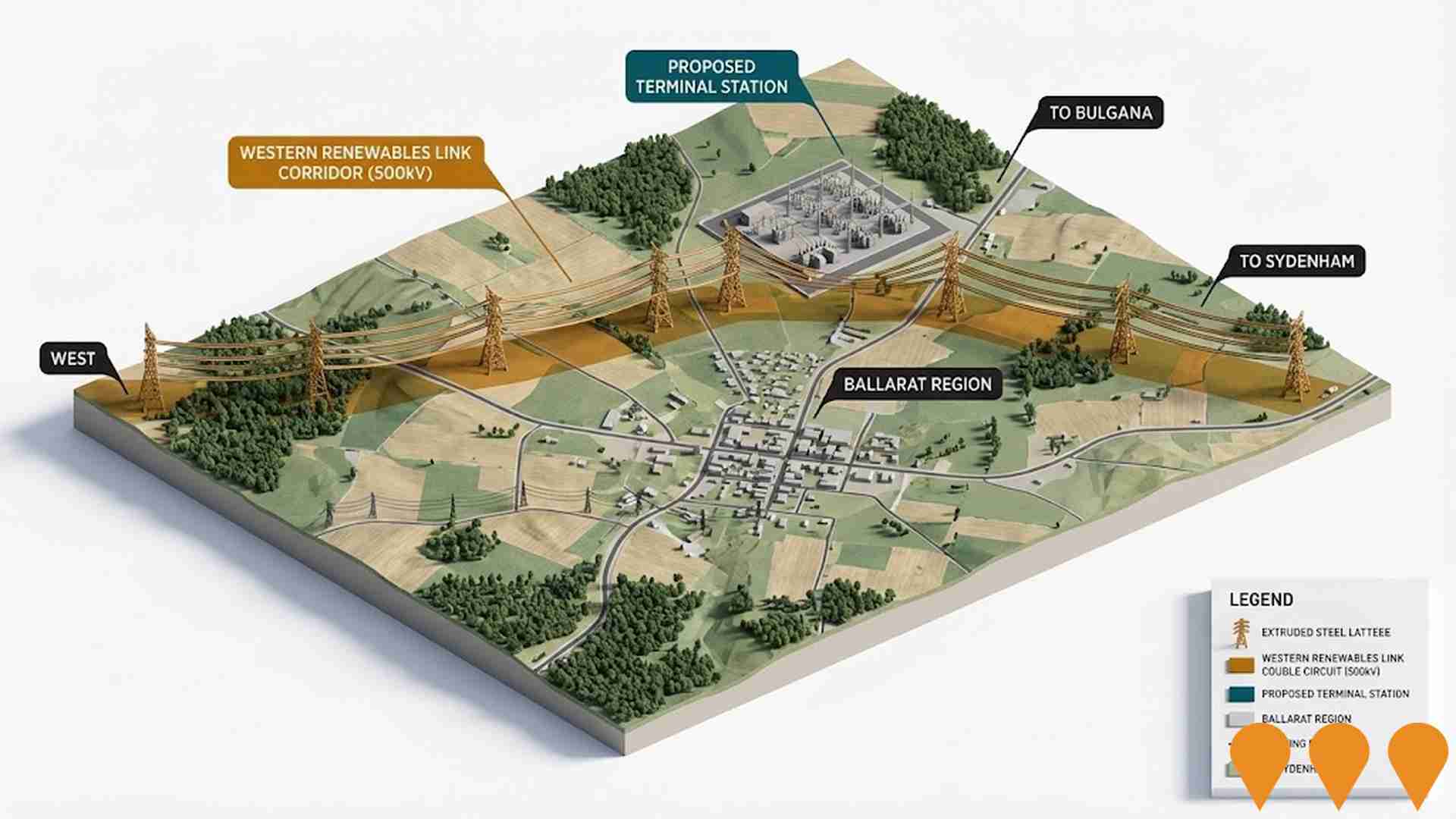
Macedon Ranges Sports Precinct
Major regional sports facility development providing multipurpose courts, ovals, and community facilities. Serving broader Macedon Ranges region with high-quality sports infrastructure for multiple codes and community events.
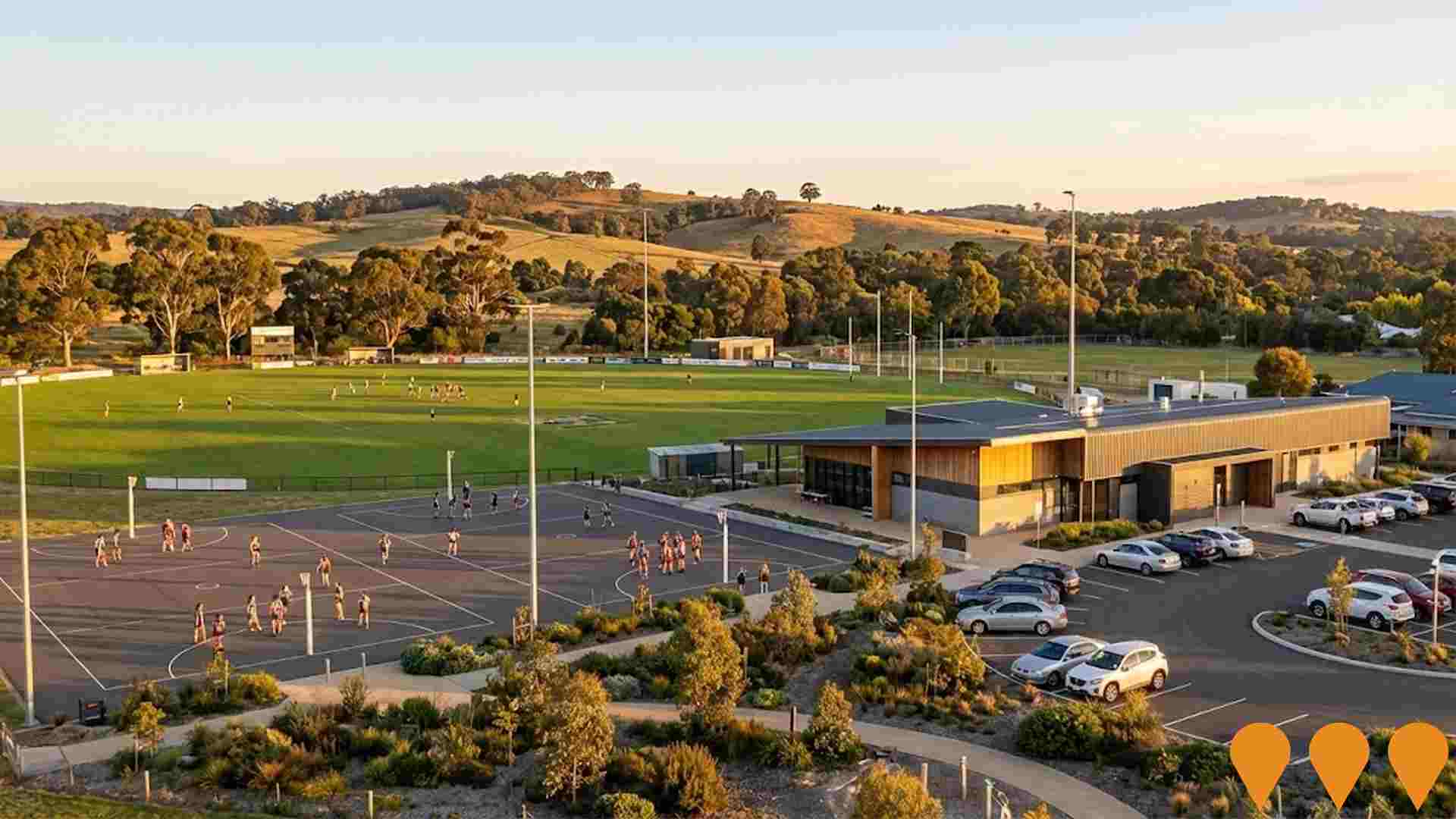
Hanging Rock to Daylesford Shared Trail
Regional shared trail connecting Hanging Rock Reserve to Daylesford, passing through Gisborne area. Multi-use path for cycling, walking, and horse riding supporting tourism and recreation in Macedon Ranges region.

Employment
Employment conditions in Woodend demonstrate exceptional strength compared to most Australian markets
Woodend's workforce is well-educated with significant representation in professional services. The unemployment rate was 1.6% as of June 2025, showing a 1.2% employment growth over the past year.
There were 3,956 residents employed while the unemployment rate was 2.2% lower than Rest of Vic.'s 3.8%. Workforce participation stood at 60.8%, slightly higher than Rest of Vic.'s 57.4%. Key employment sectors include health care & social assistance, professional & technical services, and education & training. Notably, the area has a strong specialization in professional & technical jobs, with an employment share 2.5 times the regional level.
Conversely, agriculture, forestry & fishing has limited presence, accounting for just 2.1% of employment compared to 7.5% regionally. Employment opportunities appear limited locally based on Census data analysis. Over a 12-month period ending in June 2025, employment increased by 1.2%, labour force grew by 1.8%, leading to a rise in unemployment rate by 0.6 percentage points. This contrasts with Rest of Vic., where employment fell by 0.9%, labour force contracted by 0.4%, and unemployment rose by 0.4 percentage points. Jobs and Skills Australia's national employment forecasts from May 2025 project a 6.6% increase in employment over five years and 13.7% over ten years nationally. Applying these projections to Woodend's employment mix suggests local growth of approximately 6.8% over five years and 13.8% over ten years, based on simple weighting extrapolation for illustrative purposes only.
Frequently Asked Questions - Employment
Income
Income metrics indicate excellent economic conditions, with the area achieving higher performance than 75% of national locations assessed by AreaSearch
AreaSearch's latest postcode level ATO data for financial year 2022 shows Woodend has a high national median income of $57,970 and an average income of $85,059. This compares to Rest of Vic.'s median income of $48,741 and average income of $60,693. Based on Wage Price Index growth of 12.16% since financial year 2022, current estimates for Woodend are approximately $65,019 (median) and $95,402 (average) as of September 2025. Census data indicates incomes in Woodend cluster around the 67th percentile nationally. Income brackets reveal 27.7% of residents fall within the $1,500 - 2,999 income range, similar to metropolitan regions at 30.3%. The substantial proportion of high earners (34.5%) indicates strong economic capacity in Woodend. After housing costs, residents retain 88.0% of their income, reflecting strong purchasing power and the area's SEIFA income ranking places it in the 8th decile.
Frequently Asked Questions - Income
Housing
Woodend is characterized by a predominantly suburban housing profile, with a higher proportion of rental properties than the broader region
Woodend's dwellings were 92.0% houses and 7.9% other types (semi-detached, apartments, 'other') at the latest Census, compared to Non-Metro Vic.'s 95.2% houses and 4.8% others. Home ownership in Woodend was 42.9%, with mortgaged dwellings at 42.5% and rented ones at 14.7%. The median monthly mortgage repayment was $2,000, higher than Non-Metro Vic.'s average of $1,600. Median weekly rent in Woodend was $392, compared to Non-Metro Vic.'s $320. Nationally, Woodend's mortgage repayments exceeded the Australian average of $1,863, while rents were higher than the national figure of $375.
Frequently Asked Questions - Housing
Household Composition
Woodend features high concentrations of family households, with a higher-than-average median household size
Family households constitute 77.2% of all households, including 35.4% couples with children, 30.4% couples without children, and 11.1% single parent families. Non-family households account for the remaining 22.8%, with lone person households at 21.1% and group households comprising 1.7%. The median household size is 2.6 people, larger than the Rest of Vic. average of 2.4.
Frequently Asked Questions - Households
Local Schools & Education
Educational achievement in Woodend places it within the top 10% nationally, reflecting strong academic performance and high qualification levels across the community
Educational attainment in Woodend is significantly higher than broader benchmarks. 39.2% of residents aged 15 and above hold university qualifications, compared to 21.7% in the rest of Victoria and 25.4% in the SA4 region. Bachelor degrees are the most common at 23.6%, followed by postgraduate qualifications (10.1%) and graduate diplomas (5.5%). Vocational credentials are also prominent, with 29.6% of residents aged 15 and above holding them - advanced diplomas account for 11.6% and certificates for 18.0%. Educational participation is high, with 30.3% of residents currently enrolled in formal education.
This includes 11.5% in primary education, 9.5% in secondary education, and 3.9% pursuing tertiary education. Woodend's four schools have a combined enrollment of 679 students. The area demonstrates significant socio-educational advantages and academic achievement, with an ICSEA score of 1105. The educational mix includes three primary schools and one K-12 school. Note: where schools show 'n/a' for enrolments, please refer to the parent campus.
Frequently Asked Questions - Education
Schools Detail
Nearby Services & Amenities
Transport
Transport servicing is low compared to other areas nationally based on assessment of service frequency, route connectivity and accessibility
Woodend has five active public transport stops. These are a mix of train and bus services, operated by 15 different routes. Each week, these routes provide a total of 532 passenger trips.
The accessibility of the transport system is rated as limited, with residents typically located 1312 meters from their nearest stop. On average, there are 76 trips per day across all routes, which equates to approximately 106 weekly trips per individual stop.
Frequently Asked Questions - Transport
Transport Stops Detail
Health
Woodend's residents are relatively healthy in comparison to broader Australia with a fairly standard level of common health conditions seen across both young and old age cohorts
Woodend's health metrics closely align with national benchmarks. Common health conditions are seen across both young and old age cohorts at a fairly standard level. The rate of private health cover is exceptionally high at approximately 62% of the total population (5,025 people), compared to 52.9% across Rest of Vic., and 55.3% nationally.
The most common medical conditions are mental health issues and arthritis, impacting 8.8 and 8.2% of residents respectively. 67.4% of residents declared themselves completely clear of medical ailments, compared to 63.4% across Rest of Vic.. The area has 23.2% of residents aged 65 and over (1,867 people), which is lower than the 24.9% in Rest of Vic.. Health outcomes among seniors are particularly strong, performing better than the general population in health metrics.
Frequently Asked Questions - Health
Cultural Diversity
Woodend ranks below the Australian average when compared to other local markets across a number of language and cultural background related metrics
Woodend had a cultural diversity below average, with 83.2% of its population born in Australia, 90.9% being citizens, and 95.1% speaking English only at home. Christianity was the main religion, making up 41.1%. Judaism was overrepresented at 0.2%, compared to 0.2% across Rest of Vic..
The top three ancestry groups were English (30.5%), Australian (26.7%), and Irish (12.2%). Scottish (10.3%) and Maltese (0.9%) were notably overrepresented, while Welsh was equally represented at 0.7%.
Frequently Asked Questions - Diversity
Age
Woodend hosts an older demographic, ranking in the top quartile nationwide
Woodend's median age is 46, which is slightly higher than Victoria's figure of 43 and significantly greater than Australia's national norm of 38. The age group of 45-54 years old has a strong representation in Woodend at 16.1%, compared to the Rest of Vic., while the 25-34 cohort is less prevalent at 5.1%. According to post-2021 Census data, the 75 to 84 age group has increased from 6.7% to 8.4% of Woodend's population, and the 15 to 24 cohort has risen from 9.7% to 11.2%. Conversely, the 25-34 age group has decreased from 6.6% to 5.1%. By 2041, Woodend is expected to experience significant shifts in its age composition, with the 45 to 54 group projected to grow by 44%, reaching 1,860 people from the current figure of 1,294.




